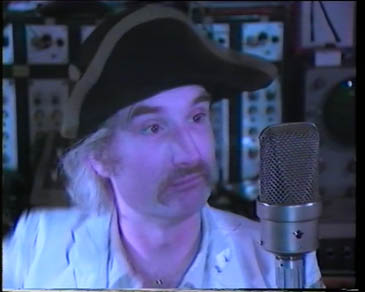
Bob Burnett: I came to CAN somewhat backwards--through the solo work of Holger Czukay. In the early '80s Holger Czukay, CAN bassist and former student of composer

"TAGO MAGO was CAN's official second album and was an attempt in achieving a mystery musical world from light to darkness and return. The album consisted not only out of regularly recorded music, but for the first time we combined 'in-between-recordings', that means the musicians were secretly recorded in the pauses when a new microphone and recording set up was being established. In that time the rest of the group just played in order to make the time pass by instead of waiting till the technical problems were solved. And there was always one microphone and one recorder on standby position for such cases. Altogether certainly a psychedelic experience, and the studio itself even turned into something new e.g. by changing dramatically the whole illumination."
Kim Kirkpatrick: Tago Mago surfaced as a double LP in 1971. I was 19, and I was open to most any musical genre. If the music was personal, rang true, experimental and/or an attempt to move all of music forward I was interested. Tago Mago fulfilled all of the above traits and filled my head with a 73-minute visit to CAN’s tribal, space world. Hypnotizing, simple grooves that I would get lost in, psychedelic to be sure,  Can was a telepathic musical crew in no hurry to return you to earth. CAN was The Grateful Dead at their improvisational best, minus the Chuck Berry, Johnny B. Goode aspect. The Dead’s all night journeys, their searching, long distance flights certainly apply to Tago Mago and Can at their peak. But CAN was all about a jazz groove, jamming, lengthy experimentation, analogous to the electric Miles of the same period. Like Bitches Brew, Live-Evil or especially Tribute to Jack Johnson. Tago Mago is a fusion of rock and jazz, as well as tape editing and studio creativity by Holgar Czukay.
Can was a telepathic musical crew in no hurry to return you to earth. CAN was The Grateful Dead at their improvisational best, minus the Chuck Berry, Johnny B. Goode aspect. The Dead’s all night journeys, their searching, long distance flights certainly apply to Tago Mago and Can at their peak. But CAN was all about a jazz groove, jamming, lengthy experimentation, analogous to the electric Miles of the same period. Like Bitches Brew, Live-Evil or especially Tribute to Jack Johnson. Tago Mago is a fusion of rock and jazz, as well as tape editing and studio creativity by Holgar Czukay.
In the sixties, in addition to studying with Stockhausen, Holgar Czukay played the french horn prior to forming CAN. He brought together:
Irmin Schmidt (a classical composer and piano player), Jaki Liebezeit (a jazz drummer), and rock guitarist Michael Karoli. Damo Suzuki joined them on vocals with the recording of Tago Mago. This release may well be the best example of CAN’s telepathic ability to groove and move together. Liebezeit’s drumming is the driving force, with a complexity not often found in rock. He creates and supports powerful grooves on Tago Mago,  and in retrospect his playing is a pioneering example of world beat music. Holgar Czukay plays bass, simple, minimal notes, but with a heaviness worthy of dub. Damo Suzuki, well, he was always the difficult one for new listeners. Be it his gibberish, yelling, whispering, or electronically altered vocals, his performances made clear this was an alternate reality for the ears. CAN and Tago Mago specifically, continues to be an amazing and relevant musical experience all these decades later. With all of their musical experimentation, the mixing of genres (electronic, rock, jazz, world beat), the songs still stick in your head like masterful pop music. I have spent entire days with one of them slithering and bumping in my head, and certainly the number one culprit who often rears his head is “Mushroom”.
and in retrospect his playing is a pioneering example of world beat music. Holgar Czukay plays bass, simple, minimal notes, but with a heaviness worthy of dub. Damo Suzuki, well, he was always the difficult one for new listeners. Be it his gibberish, yelling, whispering, or electronically altered vocals, his performances made clear this was an alternate reality for the ears. CAN and Tago Mago specifically, continues to be an amazing and relevant musical experience all these decades later. With all of their musical experimentation, the mixing of genres (electronic, rock, jazz, world beat), the songs still stick in your head like masterful pop music. I have spent entire days with one of them slithering and bumping in my head, and certainly the number one culprit who often rears his head is “Mushroom”.
"When I saw mushroom head
When I saw mushroom head
When I saw mushroom head
I was born and I was dead
I was born and I was dead"
Tago Mago was reissued and re-mastered a few years ago; you need to check it out. I’d say if you wanted to own one Can release this one is clearly it.

The first Can album I heard about 20 years ago was Tago Mago -- it still holds up today as one of my favorite krautrock records. The Can DVD box that came out in 2003 is essential if you're a hardcore fan.
ReplyDeleteDamn...I remember pulling out and playing Czukay's Movies from your record collection sophomore year. I listened and expanded. Quite difficult for a then 5'9" 120 pound (soaking wet) pasta noodle. Will definitely check out Tago Mago. Thanks.
ReplyDeletePulled out and played my copy of "Movies"! (...please tell me you used the discwasher and cleaned the stylus!!!! )
ReplyDeleteYep--you need Tago Mago now that you are beyond al dente.
--BB